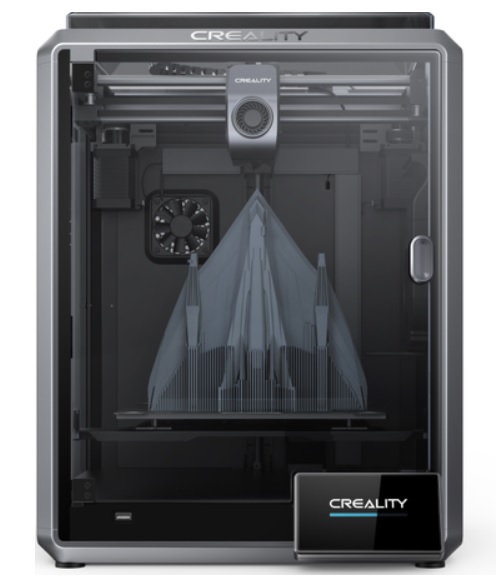Compare K1 vs CR5 PRO H
Comparison between the best 3D printers
Choose the best 3D printer at the best price. The cheapest 3D printers are here.
Buy a 3D printer here with 3D Fila.
 |
 |
|
| Model | K1[BUY K1] |
CR5 PRO H[BUY CR5 PRO H] |
| Printing Material | Filament | Filament |
| Buy Filament for Creality 3D K1 | Buy Filament forCreality 3D CR5 PRO H | |
| Estimated price | $399,00 | $1300,00 |
| Manufacturer | Creality 3D | Creality 3D |
| Release Year | 2023 | 2022 |
| Print Volume [mm] | 220x220x250 | 300x225x380 |
| Printer Size [mm] | 355x355x480 | 530x487x612 |
| Weight [kg] | 12,5 | 32,5 |
| Power Loss Recovery | YES | YES |
| Enclosed printer | YES | YES |
| Bed Leveling | Automatic | Automatic |
| Filament End Sensor | YES | YES |
| Bed type | Heated | Heated |
| Power supply system | Direct Drive | Bowden |
| Standard nozzle | 0,4 | 0,4 |
| Maximum Nozzle Temperature [°C] | 300 | 300 |
| Maximum Bed Temperature [°C] | 120 | 100 |
| Maximum printing speed [mm/s] | 600 | 100 |
| Filament holder | YES | YES |
| Camera for supervision | YES | YES |
| Recommended filaments | ABS, PLA, PETG, PET, TPU, PA, ABS, ASA, PC, PLA-CF, PA-CF, PET-CF | PLA, PETG, Tritan, Flex, ABS |
| Recommended slicers | Creality Print; Cura, Simplify3D e PrusaSlicer | Cura, Simplify, Slic3r, IdeaMaker |
| Maximum Resolution [mm] | 0,1 | 0,1 |
| Processor | ATMEGA 2560 | |
| Display | Display touchscreen 4,3'' | Display touchscreen 4,3'' |
| Power Supply | 110/220V / 350W | 110/220V / 350W |
| Connectivity | Ethernet / USB / Wi-Fi | SD / USB |
| Operating systems | Windows, Mac, Linux | Windows, Mac, Linux |
| Date of registration in the system | 2023-04-17 | 2022-11-04 |
| Release date | 2023 | 2022 |
| Extra features | The K1 is an extremely fast FDM 3D printer, reaching 600mm/s, 12 times faster than standard models. Equipped with a Core XY system and lightweight print head, it offers energy efficiency and high print quality. It stands out for its dual-gear extruder and quickly heated hotend, as well as dual cooling to prevent warping. Its robust structure ensures stability at high speed, with optimized software to speed up the printing process. | The Creality CR-5 PRO H 3D Printer stands out with a high-temperature nozzle (up to 300°C), a 300 x 225 x 380mm print volume, and a closed chamber for thermal stability. It includes BLTouch auto-leveling, a carbon-crystal silica glass base for easy model grip and removal, a filament sensor, and a resume print function. It has a 4.3-inch touchscreen interface, quiet operation, an attractive design, and is pre-assembled, ideal for technical materials. |
| Support for multiple colors and materials (AMS and CFS) | NO | NO |
Notes * |
||
| Cost-benefit | 8 / 10 | 6 / 10 |
| Hardware | 4.8 / 10 | 3.5 / 10 |
| Tela | . | . |
| Print volume | 3 / 10 | 4 / 10 |
| Performance | 5 / 10 | 1 / 10 |
| [BUY K1] | [BUY CR5 PRO H] |
Conclusion |
| In comparing the Creality 3D K1 and the CR5 PRO H 3D printers, there are significant differences that may influence a buyer’s decision. The K1 stands out for its remarkable speed, boasting a maximum printing speed of 600 mm/s, which is ideal for users prioritizing efficiency and rapid prototyping. Its compact size and lightweight design enhance its portability and ease of use, making it a great option for hobbyists and educators alike. Additionally, it offers a superior cost-benefit ratio, reflecting its ability to deliver high performance at a lower price point. Conversely, the CR5 PRO H caters to those requiring a larger print volume and the capability to print with technical materials, thanks to its high-temperature nozzle and enclosed print chamber. This printer excels in stability and is designed for users who may be working with ABS, PETG, and other advanced filaments. However, its higher price reflects these additional features and capabilities, which may not be necessary for every user. In conclusion, if budget and printing speed are key considerations, the Creality 3D K1 is the favorable choice. However, for users needing a robust machine capable of handling more demanding materials and larger prints, the CR5 PRO H may justify its higher cost. Ultimately, the decision should align with the user's specific needs and priorities in 3D printing. |

